磷酸铁锂电池MSDS
磷酸铁锂电池MSDS
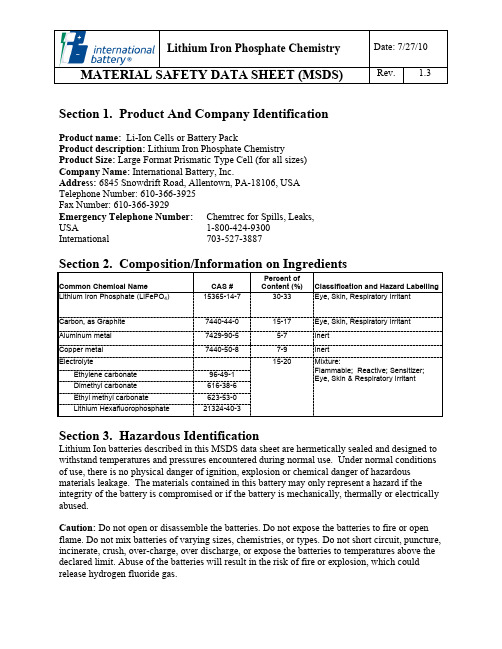
Lithium Iron Phosphate ChemistryDate: 7/27/10 Rev. 1.3MATERIAL SAFETY DATA SHEET (MSDS) Section 1. Product And Company IdentificationProduct name: Li-Ion Cells or Battery Pack Product description: Lithium Iron Phosphate Chemistry Product Size: Large Format Prismatic Type Cell (for all sizes) Company Name: International Battery, Inc. Address: 6845 Snowdrift Road, Allentown, PA-18106, USA Telephone Number: 610-366-3925 Fax Number: 610-366-3929 Emergency Telephone Number: Chemtrec for Spills, Leaks, USA 1-800-424-9300 International 703-527-3887Section 2. Composition/Information on IngredientsCommon Chemical Name Lithium Iron Phosphate (LiFePO4) Carbon, as Graphite Aluminum metal Copper metal Electrolyte Ethylene carbonate Dimethyl carbonate Ethyl methyl carbonate Lithium Hexafluorophosphate 96-49-1 616-38-6 623-53-0 21324-40-3 CAS # 15365-14-7 7440-44-0 7429-90-5 7440-50-8 Percent of Content (%) 30-33 15-17 5-7 7-9 15-20 Classification and Hazard Labelling Eye, Skin, Respiratory Irritant Eye, Skin, Respiratory Irritant Inert Inert Mixture: Flammable; Reactive; Sensitizer; Eye, Skin & Respiratory IrritantSection 3. Hazardous IdentificationLithium Ion batteries described in this MSDS data sheet are hermetically sealed and designed to withstand temperatures and pressures encountered during normal use. Under normal conditions of use, there is no physical danger of ignition, explosion or chemical danger of hazardous materials leakage. The materials contained in this battery may only represent a hazard if the integrity of the battery is compromised or if the battery is mechanically, thermally or electrically abused. Caution: Do not open or disassemble the batteries. Do not expose the batteries to fire or open flame. Do not mix batteries of varying sizes, chemistries, or types. Do not short circuit, puncture, incinerate, crush, over-charge, over discharge, or expose the batteries to temperatures above the declared limit. Abuse of the batteries will result in the risk of fire or explosion, which could release hydrogen fluoride gas.Lithium Iron Phosphate ChemistryDate: 7/27/10 Rev. 1.3MATERIAL SAFETY DATA SHEET (MSDS)Human Health Hazard: Electrolyte may irritate skin and eyes. In the event of a battery rupture, electrolyte fumes/gases can cause serious damage to the eye and can cause sensitization and irritation to the respiratory tract.Section 4. First Aid MeasuresGeneral: In an event of battery fire or rupture, evacuate personnel from the contaminated area. Eye contact: Flush with plenty of water for at least 15 minutes (eyelids held open). Seek medical attention immediately. Inhalation: Leave area immediately. Seek medical attention immediately. Skin contact: Remove contaminated clothing. Wash the area with soap and plenty of water immediately and for at least 15 minutes. Seek medical attention. Ingestion: Drink plenty of water and induce vomiting. Seek medical attention immediately.Section 5. Fire Fighting Measures:Extinguishing Media: Plenty of water, Carbon dioxide gas, Chemical powder, fire extinguishing medium and foam. Fire Fighting Procedures: Use a positive pressure self-contained breathing apparatus if batteries are involved in fire. Full protective clothing is necessary. During water application, caution is advised as burning pieces of flammable particles may be ejected from the fire. Hazardous Combustion products: Fire, excessive heat and/or over voltage conditions may produce hazardous decomposition products (i.e. electrolyte fumes and hazardous organic vapors). Vapors may be heavier than air and may travel along the ground or be moved by ventilation to an ignition source.Section 6. Accidental Release Measures:Remove all personnel from the area immediately. Wear protective gloves and protective glasses. The spilled solids are to be put into a sealed plastic bag or container and disposed off properly (after cooling if necessary). Any leaked electrolyte should be wiped off with dry cloth and disposed off properly (section 13). Do not inhale the gas and avoid skin contact. Do not bring collected materials close to fire.Section 7. Handling and Storage:Handling: Do not open or disassemble the batteries. Do not expose the batteries to fire or store near open flame. Do not mix batteries of varying sizes or chemistries. Do not connect the positive and negative battery terminals with conductive material or throw into fire. Do not heat or solder the batteries. Keep the batteries in plastic or non-conductive trays. Do not expose batteries to direct sun light for a prolonged time. Storage: Batteries should be stored in a well ventilated, cool area with sufficient clearance between batteries and walls. Store the batteries in a cool (below 300C) area and away fromLithium Iron Phosphate ChemistryDate: 7/27/10 Rev. 1.3MATERIAL SAFETY DATA SHEET (MSDS)moisture. Keep the batteries away from sources of heat, open flames, food and drink. Do not store the batteries above 550C or below -300C . Storing at elevated temperatures may reduce the life of batteries. Keep batteries away from strong oxidizers and acids. Elevated temperature storage such as 1000C may result in battery venting flammable liquid and gases.Section 8. Exposure Controls/Personal Protection:No engineering controls are required for normal operation. In case of cell leakage, increase the ventilation and use self contained full-face respiratory equipment. Common Chemical Name/General Name Lithium Iron Phosphate Carbon, As Graphite Electrolyte OSHA PEL-TWA ACGIH (2010) TLV-TWA10.0 mg/m3 (as iron fume) 5.0 mg/m3 (as iron fume) 5.0 mg/m3 (respirable fraction) 2.0 mg/m3 (respirable fraction) Not Established Not EstablishedOSHA: Occupational Safety and Health Administration PEL-TWA: Permissible Exposure Limits-Time Weighted Average Concentration ACGIH: American Council of Government Industrial Hygienists TLV-TWA: Threshold Limit Value-Time Weighted Average ConcentrationPersonal Protective Equipment Not required during normal use of the battery In the event of a ruptured battery or fire Respiratory Protection: Self-contained full-face respiratory equipment. Hand Protection: Chemical protective gloves. Eye protection: Self-contained full-face respiratory equipment. Skin and body protection: Chemical-protective clothing.Section 9. Physical and Chemical Properties:Appearance: Green/Blue plastic cases with or without ribs hermetically sealed and fitted with metallic terminals/connections. Odor: No odor pH: NA Flash Point: NA Explosion properties: NA Density: NA Solubility with indication of Solvent(s): Insoluble in water.Lithium Iron Phosphate ChemistryDate: 7/27/10 Rev. 1.3MATERIAL SAFETY DATA SHEET (MSDS) Section 10. Stability and Reactivity:Stability: Stable under normal conditions. Reactivity: When a battery is exposed to high temperatures, crushes, deformation, and external short circuit may result in venting harmful gases and volatile organics. In the event of rupture, hydrogen fluoride gas is produced in reaction with water.Section 11. Toxicological Information:There is no available data for the product itself. The information for the internal cell materials are as follows: Irritancy: The electrolytes contained in the battery can irritate eyes with any contact. Prolonged contact with skin or mucus membrane may cause irritation. Sensitization: The nervous system of respiratory organs may be stimulated sensitively. Carcinogenicity: No information is available at this time. Reproductive toxicity: No information is available at this time. Teratogenicity: No information is available at this time. Mutagenicity: No information is available at this time.Section 12. Ecological Information:Not applicable for this product.Section 13. Disposal Considerations:Batteries should be discharged fully prior to disposal. The battery terminals should be capped to prevent a short circuit. Dispose the batteries in accordance with applicable local laws. Li-ion batteries may be subject to federal, state or local regulations.Section 14. Transportation information:In the case of transportation, avoid exposure to high temperature and prevent the formation of any condensation. The container must be handled carefully. Prevent the collapse of the cargo piles and wetting by rain. Please refer to section 7 for handling and storage instruction. UN classification: International Battery, Inc. products’ shipping name is “Lithium ion batteries”.Section 15. Regulatory information:The transport of rechargeable lithium-ion batteries is regulated by various bodies (IATA, IMO, ADR, US-DOT) that follow the United Nations “Recommendation on the Transport of Dangerous Goods, Model regulations, 13th Revised edition-2003-Ref. STSG/AC.10/1 Rev. 13”. International Battery, Inc. products are assigned to UN3480 and are restricted by this regulation.Section 16. Other Information/Disclaimer:The information contained in this material data sheet has been compiled from sources considered to be dependable and is to the best of the knowledge and belief of International Battery, Inc.,Lithium Iron Phosphate ChemistryDate: 7/27/10 Rev. 1.3MATERIAL SAFETY DATA SHEET (MSDS)accurate and reliable as of the date of compilation. However, no representation, warranty (either expressed or implied) or guarantee is made to the accuracy, reliability or completeness of the information obtained herein. This information relates to the specific materials designated and may not be valid for such materials used in combination with any other materials or in any process. It is the user’s responsibility to satisfy himself as to the suitability and completeness of this information for his particular use. International battery, Inc. does not accept liability for any loss or damage that may occur whether direct, indirect, incidental or consequential, from the use of this information. International battery, Inc. does not offer warranty against patent infringement. Additional information is available by calling the telephone number designated above for this purpose.。
电池msds国际标准
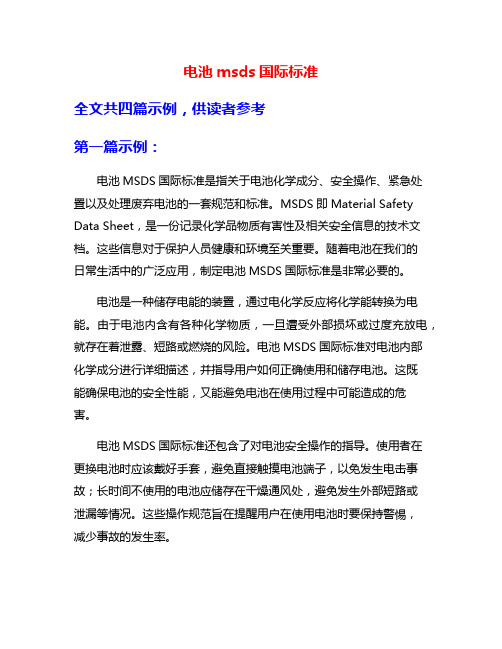
电池msds国际标准全文共四篇示例,供读者参考第一篇示例:电池MSDS国际标准是指关于电池化学成分、安全操作、紧急处置以及处理废弃电池的一套规范和标准。
MSDS即Material Safety Data Sheet,是一份记录化学品物质有害性及相关安全信息的技术文档。
这些信息对于保护人员健康和环境至关重要。
随着电池在我们的日常生活中的广泛应用,制定电池MSDS国际标准是非常必要的。
电池是一种储存电能的装置,通过电化学反应将化学能转换为电能。
由于电池内含有各种化学物质,一旦遭受外部损坏或过度充放电,就存在着泄露、短路或燃烧的风险。
电池MSDS国际标准对电池内部化学成分进行详细描述,并指导用户如何正确使用和储存电池。
这既能确保电池的安全性能,又能避免电池在使用过程中可能造成的危害。
电池MSDS国际标准还包含了对电池安全操作的指导。
使用者在更换电池时应该戴好手套,避免直接触摸电池端子,以免发生电击事故;长时间不使用的电池应储存在干燥通风处,避免发生外部短路或泄漏等情况。
这些操作规范旨在提醒用户在使用电池时要保持警惕,减少事故的发生率。
电池MSDS国际标准还详细描述了在紧急情况下应该如何处置电池。
当电池发生泄露或短路时,用户应该迅速采取必要的紧急处置措施,如戴好防护眼镜、口罩和手套,使用稀释剂清洗泄漏物等。
这些处置措施的目的是最大程度地降低事故带来的损失,并保护人员和环境的安全。
电池MSDS国际标准还规定了处理废旧电池的方法。
废旧电池内含有有害物质,如铅、镉等重金属,如果乱丢弃就会对环境和生物造成污染和伤害。
用户应该按照规定的程序将废旧电池交给专业的处理机构进行回收和处理,以最大限度地减少对环境的负面影响。
电池MSDS国际标准的制定对于保障人员健康和环境安全至关重要。
通过严格遵守这些规范和标准,可以有效预防电池使用过程中可能发生的事故,保护人员的生命财产安全,同时减少对环境的污染。
希望未来能够加强对电池MSDS国际标准的宣传和执行力度,使得电池使用更加安全可靠。
磷酸铁锂的详细资料
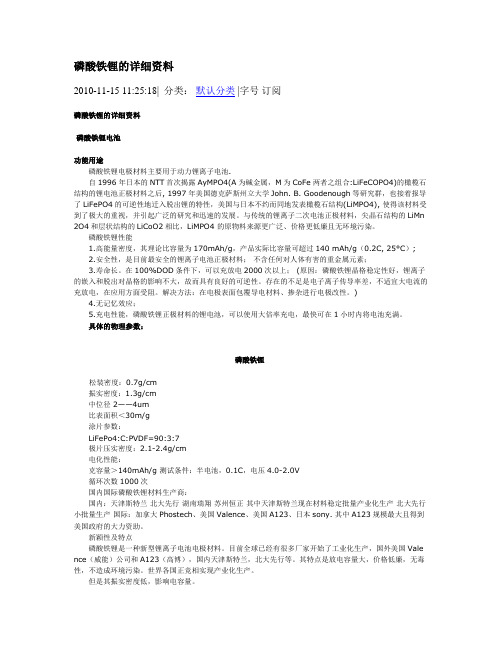
磷酸铁锂的详细资料2010-11-15 11:25:18| 分类:默认分类 |字号订阅磷酸铁锂的详细资料磷酸铁锂电池功能用途磷酸铁锂电极材料主要用于动力锂离子电池.自1996年日本的NTT首次揭露AyMPO4(A为碱金属,M为CoFe两者之组合:LiFeCOPO4)的橄榄石结构的锂电池正极材料之后, 1997年美国德克萨斯州立大学John. B. Goodenough等研究群,也接着报导了LiFePO4的可逆性地迁入脱出锂的特性,美国与日本不约而同地发表橄榄石结构(LiMPO4), 使得该材料受到了极大的重视,并引起广泛的研究和迅速的发展。
与传统的锂离子二次电池正极材料,尖晶石结构的LiMn 2O4和层状结构的LiCoO2相比,LiMPO4 的原物料来源更广泛、价格更低廉且无环境污染。
磷酸铁锂性能1.高能量密度,其理论比容量为170mAh/g,产品实际比容量可超过140 mAh/g(0.2C, 25°C);2.安全性,是目前最安全的锂离子电池正极材料;不含任何对人体有害的重金属元素;3.寿命长。
在100%DOD条件下,可以充放电2000次以上; (原因:磷酸铁锂晶格稳定性好,锂离子的嵌入和脱出对晶格的影响不大,故而具有良好的可逆性。
存在的不足是电子离子传导率差,不适宜大电流的充放电,在应用方面受阻。
解决方法:在电极表面包覆导电材料、掺杂进行电极改性。
)4.无记忆效应;5.充电性能,磷酸铁锂正极材料的锂电池,可以使用大倍率充电,最快可在1小时内将电池充满。
具体的物理参数:磷酸铁锂松装密度:0.7g/cm振实密度:1.3g/cm中位径 2——4um比表面积<30m/g涂片参数:LiFePo4:C:PVDF=90:3:7极片压实密度:2.1-2.4g/cm电化性能:克容量>140mAh/g 测试条件:半电池,0.1C,电压4.0-2.0V循环次数1000次国内国际磷酸铁锂材料生产商:国内:天津斯特兰北大先行湖南瑞翔苏州恒正其中天津斯特兰现在材料稳定批量产业化生产北大先行小批量生产国际:加拿大Phostech、美国Valence、美国A123、日本sony. 其中A123规模最大且得到美国政府的大力资助。
磷酸铁锂的详细资料

磷酸铁锂的详细资料2010-11-15 11:25:18| 分类:默认分类|字号订阅磷酸铁锂的详细资料磷酸铁锂电池功能用途ﻭ磷酸铁锂电极材料主要用于动力锂离子电池.自1996年日本的NTT首次揭露AyMPO4(A为碱金属,M为CoFe两者之组合:LiFeCOPO4)的橄榄石结构的锂电池正极材料之后, 1997年美国德克萨斯州立大学John. B. Goodenough等研究群,也接着报导了LiFePO4的可逆性地迁入脱出锂的特性,美国与日本不约而同地发表橄榄石结构(LiMPO4),使得该材料受到了极大的重视,并引起广泛的研究和迅速的发展。
与传统的锂离子二次电池正极材料,尖晶石结构的LiMn2O4和层状结构的LiCoO2相比,LiMPO4的原物料来源更广泛、价格更低廉且无环境1.高能量密度,其理论比容量为170mAh/g,产品实际比容量可超过140污染。
ﻭ磷酸铁锂性能ﻭmAh/g(0.2C, 25°C); ﻭ2.安全性,是目前最安全的锂离子电池正极材料; 不含任何对人体有害的重金属元素;ﻭ 3.寿命长。
在100%DOD条件下,可以充放电2000次以上;(原因:磷酸铁锂晶格稳定性好,锂离子的嵌入和脱出对晶格的影响不大,故而具有良好的可逆性。
存在的不足是电子离子传导率差,不适宜大电流的充放电,在应用方面受阻。
解决方法:在电极表面包覆导电材料、掺杂进行电极改性。
)ﻭ 4.无记忆效应;5.充电性能,磷酸铁锂正极材料的锂电池,可以使用大倍率充电,最快可在1小时内将电池充满。
ﻭ具体的物理参数:ﻭ磷酸铁锂松装密度:0.7g/cmﻭ振实密度:1.3g/cm中位径 2——4umﻭ比表面积<30m/g涂片参数:ﻭLiFePo4:C:PVDF=90:3:7ﻭ极片压实密度:2.1-2.4g/cm电化性能:克容量>140mAh/g测试条件:半电池,0.1C,电压4.0-2.0V循环次数1000次ﻭ国内国际磷酸铁锂材料生产商:国内:天津斯特兰北大先行湖南瑞翔苏州恒正其中天津斯特兰现在材料稳定批量产业化生产北大先行小批量生产国际:加拿大Phostech、美国Valence、美国A123、日本sony.其中A123规模最大且得到美国政府的大力资助。
磷酸铁锂电池说明书
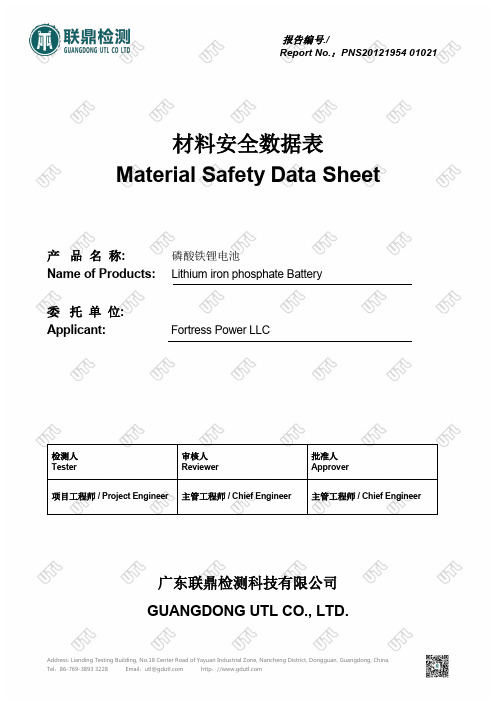
报告编号./Report No.:PNS20121954 01021材料安全数据表Material Safety Data Sheet产 品 名 称: 磷酸铁锂电池Name of Products: Lithium iron phosphate Battery Fortress Power LLC委 托 单 位: Applicant:检测人Tester审核人Reviewer批准人Approver项目工程师 / Project Engineer主管工程师 / Chief Engineer主管工程师 / Chief Engineer广东联鼎检测科技有限公司GUANGDONG UTL CO., LTD.1.Identification of the product and supplier (产品和厂商信息)样品名称Name of goods 磷酸铁锂电池Lithium iron phosphate Battery样品型号Type/ModelEVault Max规格Rating51.2V, 360Ah, 18.5KWh委托单位Commissioned byFortress Power LLC委托单位地址Commissioner address505 Keystone Rd Southampton, PA 18966, US生产厂地址Manufacturer address 惠州仲恺高新区东江高新科技产业园东兴片区东新大道113号Dongxin Road 113, Dongjiang High-Tech Industrial, Zhongkai District, 516055 Huizhou, Guangdong Province, China鉴定依据Inspection according to 联合国《关于危险品货物运输的建议书》UN “Recommendations on the TRANSPORT OF DANGEROUS GOODS”紧急联系电话Emergency telephone call +86-755-27651888接样日期 / Receiving date: 2021-02-04签发日期 / Date of issue: 2021-05-06position Information (成分/组成信息)化学成分Chemical Composition化学式Chemical Formula重量百分比Weight(%)CAS编号CAS Number磷酸铁锂/ Lithium IronPhosphateLiFePO432-3815365-14-7 六氟磷酸锂/ LithiumHexafluorophosphateLiPF6 2.5-4.5 21324-40-3 铜/ Copper Cu 9-137440-50-8 石墨/ Graphite C24X1216-207782-42-5 铝/ Aluminium AI 13-177429-90-5 其他/ Others -- 17-23--3.Hazards Identification (危险性概述)爆炸危险性Explosive risk 该物品不属于爆炸危险品This article does not belong to the explosion dangerous goods易燃危险性Flammable risk 该物品不属于易燃危险品This article does not belong to the flammable material氧化危险性Oxidation risk 该物品不属于氧化危险品This article does not belong to the oxidation of dangerous goods毒害危险性Toxic risk 该物品不属于毒害危险品This article does not belong to the toxic dangerous goods放射危险性Radioactive risk 该物品不属于放射危险品This article does not belong to the radiation of dangerous goods腐蚀危险性Mordant risk 该物品不属于腐蚀危险品This article does not belong to the corrosion of dangerous goods其他危险性other risk 该电池瓦时率为18.5KWh,属于第九类危险品货物。
磷酸铁锂电池介绍

1 .高电 压;
1 .成本 高;
2 .能量 密度极 高;
2 .一致 性差;
3 .功率 密度极 高;
3 .怕过 充电过 放电;
1 .能力 密度极 高;
1 .生产 工艺复 杂;
2 .功率 密度极 高;
2 .成本 极高;
3 .高电 压;
3 .单体 容量小 ;
4 .耐高 低温放 电;
4 .不适 合动力 性电源 ;
强
自放电
月度自放电小于 3%
大于 10%
充电性能
很好
一般
充电时间仅 是铅酸的 1/4
磷酸铁锂电池(LiFePO4 资料介绍) 5,磷酸铁锂电池与钴酸锂及锰酸锂对比
常用电池的主要性能指标
电池类型
磷酸 铁锂 电池
钴酸 锂 电池
锰酸 锂 电池
电池构成 正极/电解质/负极
LiFePO4/LiBF6/C L i C o O 2 /有机 液/ C LiMnO2(LiCoO2)/LiBF6/C
380
美国贝尔实验
锰酸锂电池
室
500 110 400 130 250 1500 3000
600
磷酸铁锂电池(LiFePO4 资料介绍)
品质保证: 六个一致、三道把关 • 六个一致是指组合配对的单体必须保证电池的 • 1、电压一致性 • 2、内阻一致性 • 3、容量一致性 • 4、平台一致性 • 5、恒流比一致性 • 6、带电量一致性 • • • 三道把关是针对组合电池过程中 • 1、单体把关 • 2、并联模块把关 • 3、成型电池组把关
磷酸铁锂电池(LiFePO4 资料介绍)
2,磷酸铁锂电池充放电原理图
LiFePO4 电池的内部结构如图下图所示
(完整版)磷酸铁锂电池简介
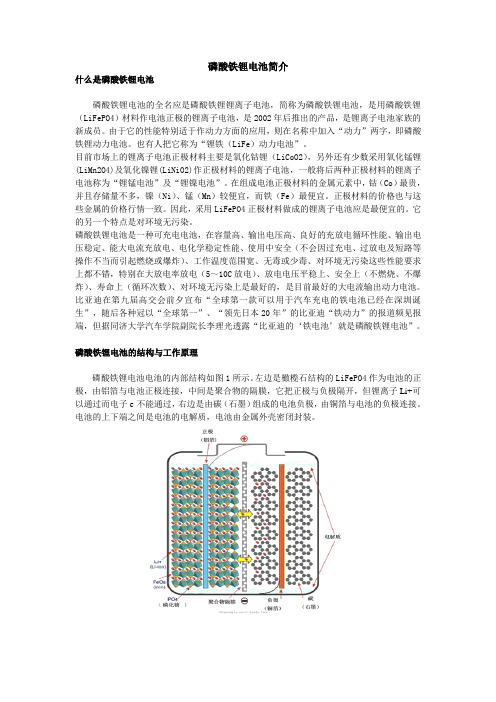
磷酸铁锂电池简介什么是磷酸铁锂电池磷酸铁锂电池的全名应是磷酸铁锂锂离子电池,简称为磷酸铁锂电池,是用磷酸铁锂(LiFePO4)材料作电池正极的锂离子电池,是2002年后推出的产品,是锂离子电池家族的新成员。
由于它的性能特别适于作动力方面的应用,则在名称中加入“动力”两字,即磷酸铁锂动力电池。
也有人把它称为“锂铁(LiFe)动力电池”。
目前市场上的锂离子电池正极材料主要是氧化钴锂(LiCoO2),另外还有少数采用氧化锰锂(LiMn2O4)及氧化镍锂(LiNiO2)作正极材料的锂离子电池,一般将后两种正极材料的锂离子电池称为“锂锰电池”及“锂镍电池”。
在组成电池正极材料的金属元素中,钴(Co)最贵,并且存储量不多,镍(Ni)、锰(Mn)较便宜,而铁(Fe)最便宜。
正极材料的价格也与这些金属的价格行情一致。
因此,采用LiFePO4正极材料做成的锂离子电池应是最便宜的。
它的另一个特点是对环境无污染。
磷酸铁锂电池是一种可充电电池,在容量高、输出电压高、良好的充放电循环性能、输出电压稳定、能大电流充放电、电化学稳定性能、使用中安全(不会因过充电、过放电及短路等操作不当而引起燃烧或爆炸)、工作温度范围宽、无毒或少毒、对环境无污染这些性能要求上都不错,特别在大放电率放电(5~10C放电)、放电电压平稳上、安全上(不燃烧、不爆炸)、寿命上(循环次数)、对环境无污染上是最好的,是目前最好的大电流输出动力电池。
比亚迪在第九届高交会前夕宣布“全球第一款可以用于汽车充电的铁电池已经在深圳诞生”,随后各种冠以“全球第一”、“领先日本20年”的比亚迪“铁动力”的报道频见报端,但据同济大学汽车学院副院长李理光透露“比亚迪的‘铁电池’就是磷酸铁锂电池”。
磷酸铁锂电池的结构与工作原理磷酸铁锂电池电池的内部结构如图1所示。
左边是橄榄石结构的LiFePO4作为电池的正极,由铝箔与电池正极连接,中间是聚合物的隔膜,它把正极与负极隔开,但锂离子Li+可以通过而电子e-不能通过,右边是由碳(石墨)组成的电池负极,由铜箔与电池的负极连接。
磷酸铁锂的化学品安全说明书

磷酸铁锂的化学品安全说明书
作为一种常见的电池材料,磷酸铁锂具有高能量密度、长循环寿
命等优点,已经被广泛应用于电动汽车、储能系统等领域。
但是,它
也存在一定的安全隐患,需要引起各方的注意。
首先,存储和运输过程中需要注意避免机械碰撞、高温、湿度过
大等情况,以防电池受损或爆炸。
在使用过程中,也需要避免电池过
度充放电,以及使用非原厂充电器等不安全设备。
如果电池出现异常,例如发热、冒烟、发出异味等情况,应立即停止使用并咨询相关专业
人员。
其次,磷酸铁锂电池含有一定量的有毒物质,如锂、磷酸盐等。
因此,对于电池的处理和回收需要格外关注,避免对环境和人体造成
危害。
在电池报废或寿命结束后,应将电池归还到正规的处理厂商或
回收站点进行处理和回收,绝不可将其随意丢弃或焚烧。
最后,作为普通用户,我们应该加强对电池的安全知识学习和意
识培养,确保正确使用和处理电池,避免因为人为原因导致电池出现
安全问题。
与此同时,政府和相关机构也应加强对电池安全的监管和
推广,促进电池行业的可持续发展。
总之,磷酸铁锂电池作为一种常用的电源设备,需要我们重视其
安全性,保障其正常运行和安全使用。
只有在保持良好的安全意识和
行为习惯的前提下,才能真正发挥其优良的性能和效益,为我们的生
活和社会做出更大的贡献。
磷酸铁锂
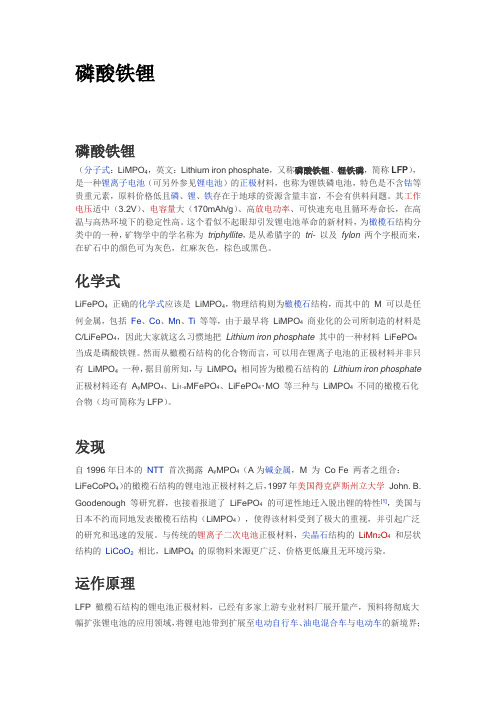
磷酸铁锂磷酸铁锂(分子式:LiMPO4,英文:Lithium iron phosphate,又称磷酸铁锂、锂铁磷,简称LFP),是一种锂离子电池(可另外参见锂电池)的正极材料,也称为锂铁磷电池,特色是不含钴等贵重元素,原料价格低且磷、锂、铁存在于地球的资源含量丰富,不会有供料问题。
其工作电压适中(3.2V)、电容量大(170mAh/g)、高放电功率、可快速充电且循环寿命长,在高温与高热环境下的稳定性高。
这个看似不起眼却引发锂电池革命的新材料,为橄榄石结构分类中的一种,矿物学中的学名称为triphyllite,是从希腊字的tri-以及fylon两个字根而来,在矿石中的颜色可为灰色,红麻灰色,棕色或黑色。
化学式LiFePO4正确的化学式应该是LiMPO4,物理结构则为橄榄石结构,而其中的M 可以是任何金属,包括Fe、Co、Mn、Ti等等,由于最早将LiMPO4商业化的公司所制造的材料是C/LiFePO4,因此大家就这么习惯地把Lithium iron phosphate其中的一种材料LiFePO4当成是磷酸铁锂。
然而从橄榄石结构的化合物而言,可以用在锂离子电池的正极材料并非只有LiMPO4一种,据目前所知,与LiMPO4相同皆为橄榄石结构的Lithium iron phosphate 正极材料还有A y MPO4、Li1-x MFePO4、LiFePO4・MO 等三种与LiMPO4不同的橄榄石化合物(均可简称为LFP)。
发现自1996年日本的NTT首次揭露A y MPO4(A为碱金属,M 为Co Fe 两者之组合:LiFeCoPO4)的橄榄石结构的锂电池正极材料之后,1997年美国得克萨斯州立大学John. B. Goodenough 等研究群,也接着报道了LiFePO4的可逆性地迁入脱出锂的特性[1],美国与日本不约而同地发表橄榄石结构(LiMPO4),使得该材料受到了极大的重视,并引起广泛的研究和迅速的发展。
锂电池MSDS

MSDS 报 告(MSDS Report)PONY 谱 尼 测 试Pony Testing International Group样品名称( Sample Description )锂电池委托单位( Applicant )合肥国轩高科动力能源有限公司报告编号(Report ID):0907091-192化学品安全技术说明书第一部分化学品及企业标识化学品中文名称:锂电池化学品英文名称:Lithium Ion Cells or Battery Packs生产企业名称:合肥国轩高科动力能源有限公司地址:中国安徽省合肥市瑶海工业园纬D路邮编:230011电话:+86-551-2100908应急电话:+86-551-2100908传真:+86-551-2100915电子邮件:janet_zha@第二部分成分/组成信息成分含量:化学名称 CASNo.编号分子式成分 EC 磷酸铁锂/ LiFePO4 35-40% / 碳7440-44-0 C 12-15% 231-153-3铜7440-50-8 Cu 7-10% 231-159-6石墨7782-42-5 C 8% 231-955-3 聚偏氟乙烯24937-79-9 (C2H2F2)n 6% / 铝7429-90-5 Al 5% 231-072-3 碳酸乙烯酯96-49-1 C3H4O3 5% 202-510-0 镍7440-02-0 Ni 2-5% 231-111-4 碳酸二甲酯616-38-6 C3H6O3 2-5% 210-478-4 锂7439-93-2 Li 2-3% 231-102-5第三部分危险性概述紧急概况:警告,不要打开或拆卸,不要暴露在火焰或明火下。
不要将型号不同,化学性质不同或类型不同的电池混合放置。
在着火条件下有爆炸和烧伤的危险。
不要短路,挤压,焚烧或拆卸电池。
潜在的健康危害眼睛:正常使用下没有特殊危害,电池破损引起严重的刺激或者是化学烧伤。
磷酸铁锂

天津斯特兰/
磷酸铁锂
1、产品名称:磷酸铁锂(LiFePO4)
2、规格型号:SLFP-PD80
3、材料的适用范围:适宜10C左右放电,如电动车、小型电动工具等要求中等功率输出领域。
4
附件1 XRD
附件2 扫描电镜
粒度分布
5、材料电化学性能:
6、材料包装:真空铝塑密封包装,无破损,无撒漏。
7、材料的保质期:保质期12个月。
8、材料储存:密封保存,严禁在潮湿、高温下储存。
磷酸铁锂
1、产品名称:磷酸铁锂(LiFePO4)
2、规格型号:SLFP-PT30
3、材料的适用范围:适宜30C 左右放电,如大型电动工具、军事等要求瞬间大功率放电的领域。
4、材料物理特性:
附件1 XRD
附件2 扫描电镜
粒度分布
5、材料电化学性能:
6、材料包装:真空铝塑密封包装,无破损,无撒漏。
7、材料的保质期:保质期12个月。
8、材料储存:密封保存,严禁在潮湿、高温下储存。
磷酸铁锂
1、产品名称:磷酸铁锂(LiFePO4)
2、规格型号:SLFP-ES01
3、材料的适用范围:适宜1C左右放电,如UPS电源、草坪灯、矿灯等要求输出功率不高的领域。
4、材料的粒度分布:
5、材料的晶体结构:
6、材料的微观结构:
7、材料物理特性:
8、材料电化学性能:
9、材料的充放电曲线:
10、材料包装:真空铝塑密封包装,无破损,无撒漏。
11、材料的保质期:保质期12个月。
12、材料储存:密封保存,严禁在潮湿、高温下储存。
(完整版)磷酸铁锂电池简介

磷酸铁锂电池简介什么是磷酸铁锂电池磷酸铁锂电池的全名应是磷酸铁锂锂离子电池,简称为磷酸铁锂电池,是用磷酸铁锂(LiFePO4)材料作电池正极的锂离子电池,是2002年后推出的产品,是锂离子电池家族的新成员。
由于它的性能特别适于作动力方面的应用,则在名称中加入“动力”两字,即磷酸铁锂动力电池。
也有人把它称为“锂铁(LiFe)动力电池”。
目前市场上的锂离子电池正极材料主要是氧化钴锂(LiCoO2),另外还有少数采用氧化锰锂(LiMn2O4)及氧化镍锂(LiNiO2)作正极材料的锂离子电池,一般将后两种正极材料的锂离子电池称为“锂锰电池”及“锂镍电池”。
在组成电池正极材料的金属元素中,钴(Co)最贵,并且存储量不多,镍(Ni)、锰(Mn)较便宜,而铁(Fe)最便宜。
正极材料的价格也与这些金属的价格行情一致。
因此,采用LiFePO4正极材料做成的锂离子电池应是最便宜的。
它的另一个特点是对环境无污染。
磷酸铁锂电池是一种可充电电池,在容量高、输出电压高、良好的充放电循环性能、输出电压稳定、能大电流充放电、电化学稳定性能、使用中安全(不会因过充电、过放电及短路等操作不当而引起燃烧或爆炸)、工作温度范围宽、无毒或少毒、对环境无污染这些性能要求上都不错,特别在大放电率放电(5~10C放电)、放电电压平稳上、安全上(不燃烧、不爆炸)、寿命上(循环次数)、对环境无污染上是最好的,是目前最好的大电流输出动力电池。
比亚迪在第九届高交会前夕宣布“全球第一款可以用于汽车充电的铁电池已经在深圳诞生”,随后各种冠以“全球第一”、“领先日本20年”的比亚迪“铁动力”的报道频见报端,但据同济大学汽车学院副院长李理光透露“比亚迪的‘铁电池’就是磷酸铁锂电池”。
磷酸铁锂电池的结构与工作原理磷酸铁锂电池电池的内部结构如图1所示。
左边是橄榄石结构的LiFePO4作为电池的正极,由铝箔与电池正极连接,中间是聚合物的隔膜,它把正极与负极隔开,但锂离子Li+可以通过而电子e-不能通过,右边是由碳(石墨)组成的电池负极,由铜箔与电池的负极连接。
磷酸铁锂电池MSDS

Product Name: High Energy Lithium Ion Battery, Phosphate BasedModel: K2B24V10EB Battery (8s3p/26650ev cell battery pack with circuit)Product Use: ElectricalChemical Family: MixtureSynonyms: LFP Battery, Lithium Iron Phosphate BatteryManufacturer: : K2 Energy Solutions1125 American Pacific Dr, Suite CHenderson, NV 89074Phone Number: 702-478-3590Fax: 702-558-018024-Hour Emergency: Chemtrec: 800-424-9300USA: This battery is an article pursuant to 29 CFR 1910.1200 and, as such, is not subject to the OSHA Hazard Communication Standard requirement. The information contained in this Material Safety Data Sheet contains valuable information critical to the safe handling and proper use of the product. This MSDS should be retained and available for employees and other users of this product.Canada: This is not a controlled product under WHMIS. This product meets the definition of a “manufactured article” and is not subject to the regulations of the Hazardous Products Act. Preparation Hazards and Classification: Not dangerous with normal use. The battery should not be disassembled or incinerated. Exposure to the ingredients contained within or their combustion products could be harmful.Appearance, Color, and Odor: Solid object, no odor.Primary Route(s) of Exposure: Risk of exposure will only occur if the battery or cell is mechanically, thermally or electrically abused and the enclosure is compromised. If this occurs, exposure to electrolyte solutions contained within the battery or cell may occur by inhalation, eye contact, skin contact and ingestion.Potential Health Effects:Inhalation: Inhalation of material from a sealed battery is not an expected route ofexposure. Vapors or mists from a ruptured battery may cause respiratory irritation.Ingestion: Swallowing of material from a sealed battery is not an expected route ofexposure. Swallowing mists from a ruptured battery may cause respiratory irritation,chemical burns of the mouth and gastrointestinal tract irritation.Skin: Contact between the battery and skin will not cause any harm. Skin contact withpositive and negative terminals of high voltages may cause burns to the skin. Skincontact with a ruptured battery can cause skin irritation.Eye: Contact between the battery and eye will not cause any harm. Eye contact with thecontents of a ruptured battery can cause severe irritation to the eye.Medical Conditions Aggravated by Exposure: Not Availablepersists, seek medical attention.Eye Contact: Wash affected eye with lukewarm water for at least 30 minutes. Rinse with saline solution if possible. Seek medical attention.Inhalation: Move victim to fresh air and remove source of contamination from area. Seek medical attention.Caution: In all cases if irritation persists, seek medical assistance at once.to extinguish a battery fireFire Fighting Procedure: Put on fully protective gear, including self-contained breathing apparatus, goggles, fireproofing jacket and gloves.Unusual Fire and Explosion Hazards: Exposing battery pack or cell to excessive heat, fire or over voltage condition may cause a leak, fire, hazardous vapors and hazardous decomposition products. Damaged or opened cells or batteries can result in rapid heating and the release of flammable vapors.shovel and cover battery with sand or vermiculite, place in an approved container and dispose in accordance with section 13.puncture battery.Storage: Insulate positive and negative terminals to avoid short circuit. Store in a cool and well ventilated area and avoid direct sunlight. Elevated temperatures can result in reduced battery life.contained full face respiratory mask.Eye Protection: Not necessary under normal use. Wear safety goggles if handling a ruptured or leaking cell or battery pack.Hand Protection: Not necessary under normal use. Wear Viton rubber gloves if handling a ruptured or leaking cell or battery pack.Skin Protection: Not necessary under normal use. Wear rubber apron and Viton rubber gloves if handling a ruptured or leaking cell or battery pack.Conditions to Avoid: Avoid exposing battery to high temperatures. Do not incinerate, deform, mutilate, crush, pierce, short circuit or disassemble.Materials to Avoid: Not ApplicableHazardous Decomposition Products: Combustible vapors may be released if exposed to fire. Possibility of Hazardous Reactions: Not available.abused and the enclosure is compromised.Neurological Effects: Not applicable.Sensitization: Not applicable.Teratogenicity: Not applicable.Reproductive Toxicity: Not applicable.Mutagenicity (Genetic Effects): Not applicable.Toxicologically Synergistic Materials: Not availablePersistence and degradability: Not available.Mobility: Not available.Ecotoxicity: Not available.Other adverse effects: Not available.laws and regulations.USA: Dispose of in accordance with local, state and federal laws and regulations.Canada: Dispose of in accordance with local, state and federal laws and regulations.EC: Dispose of in accordance with relevant EC Directives.Some single lithium ion cells and multi cell battery packs are exempted from Class 9. No class 9 marking, specification packaging, or Class 9 labels are required.Use lithium ion battery labels for transport of lithium ion batteries which are not assigned Class 9.Use Class 9 Miscellaneous Dangerous Goods and UN Identification labels for transportation of lithium ion batteries which are assigned Class 9. Refer to relevant transportation documents.Lithium and lithium ion cells and batteries are regulated in the U.S. in accordance with Part 49 of the Code of Federal Regulations, (49 CFR Sections 105-180) of the U.S. Hazardous Materials Regulations.USATSCA Status: All ingredients in the product are listed on the TSCA inventory.SARA Title III:Sec. 302/304: NoneSec. 311/312: NoneSec. 313: NoneCERCLA RQ: NoneCalifornia Prop 65:This product does not contain chemicals know to the State of California to cause cancer or reproductive toxicity.CanadaThis product has been classified in accordance with the hazard criteria of the Controlled Products Regulations and the MSDS contains all the information required by the Controlled Products Regulations.WHMIS Classification: Not ControlledNew Substance Notification Regulations: All ingredients in the product are listed, as required, on Canada’s Domestic Substance List.NPRI Substances (National Pollutant Release Inventory): This product does not contain anyNPRI chemicals.EC Classification for the Substance/ Preparation:Symbol: This product is not classified as dangerous according to Directive 1999/45/ECand it’s amendments.Risk Phrases: NoneSafety Phrases: S2: Keep out of the reach of children.Revision Date: May, 30, 2010Revision Summary: 1 : Engineering Pre-Release.Prepared by: K2 Energy Solutions1125 American Pacific Dr, Suite CHenderson, NV 89074Phone: (702)478-3590Disclaimer: The information and recommendations set forth are made in good faith and accurate at the date of preparation. K2 Energy Solutions makes no warranty expressed or implied with respect to this information and recommendations and disclaims all liability from reliance on it.。
磷酸铁锂电池特点

磷酸铁锂电池特点
磷酸铁锂电池是一种非常常见的锂离子电池类型,它具备以下特点。
首先,磷酸铁锂电池具有较高的安全性。
相比其他锂离子电池,
磷酸铁锂电池的稳定性更高,不易发生爆炸或着火等危险情况。
这是
因为磷酸铁锂电池采用了磷酸盐作为正极材料,相比传统的钴酸锂电
池和三元材料电池,磷酸铁锂电池具有更低的热失控风险。
其次,磷酸铁锂电池具有较长的寿命。
磷酸铁锂电池的循环寿命
可以达到2000次以上,相比其他电池类型具有更好的耐久性。
这是因
为磷酸铁锂电池的正极材料磷酸铁锂具有较高的结晶稳定性,能够减
少正极材料的脱锂和结构损耗。
此外,磷酸铁锂电池具有较低的自放电率。
自放电率是指电池在
放置一段时间后的电荷损失速度,磷酸铁锂电池的自放电率相对较低。
这意味着即使长时间不使用,磷酸铁锂电池也能保持较长的电池续航
能力。
磷酸铁锂电池还具有高温性能较好的特点。
相对于其他锂离子电池,磷酸铁锂电池在高温环境下更加稳定。
这是因为磷酸铁锂电池的
磷酸盐电解液对高温更加耐受,不易发生气化反应。
最后,磷酸铁锂电池具有良好的环保性能。
磷酸铁锂电池使用的
材料均为绿色环保材料,不会对环境造成污染。
与其它电池类型相比,磷酸铁锂电池的生产过程和废弃处理环节对环境的影响较小。
总之,磷酸铁锂电池具备较高的安全性、较长的寿命、较低的自
放电率、较好的高温性能和良好的环保性能。
由于这些特点,磷酸铁
锂电池被广泛应用于电动车、储能系统、移动设备等领域,并成为主
流的锂离子电池技术之一。
磷酸铁锂电池性能及应用介绍

磷酸铁锂电池性能及应用介绍从正负极材料锂电池还分为:钴酸锂(LiCoO2)电池、锰酸锂(LiMn2O4),磷酸铁锂电池。
Sony公司推出的第一块锂电池中,正极材料是钴酸锂,负极材料为碳。
其中,决定电池的可充电最大容量及开路电压的主要是正极材料。
磷酸铁锂电池是指用磷酸铁锂作为正极材料的锂电池。
锂电池的正极材料有很多种,主要有钴酸锂、锰酸锂、镍酸锂、三元材料、磷酸铁锂等。
其中钴酸锂是目前绝大多数锂电池使用的正极材料,而其它正极材料由于多种原因,目前在市场上还没有大量生产。
磷酸铁锂也是其中一种锂电池。
从材料的原理上讲,磷酸铁锂也是一种嵌入/脱嵌过程,这一原理与钴酸锂,锰酸锂完全相同。
磷酸铁锂电池是用来做锂二次电池的, 现在主要方向是动力电池,相对NI-MH,Ni-Cd电池有很大优势。
磷酸铁锂电池的特性1、超长寿命长寿命铅酸电池的循环寿命在300次左右,最高也就500次,而磷酸铁锂动力电池,循环寿命达到2000次以上,标准充电(5小时率)使用,可达到2000次。
同质量的铅酸电池是“新半年、旧半年、维护维护又半年”,最多也就1—1.5年时间,而磷酸铁锂电池在同样条件下使用,将达到7-8年。
综合考虑,性能价格比将为铅酸电池的4倍以上。
2、使用安全磷酸铁锂完全解决了钴酸锂和锰酸锂的安全隐患问题,钴酸锂和锰酸锂在强烈的碰撞下会产生爆炸对消费者的生命安全构成威胁,而磷酸铁锂以经过严格的安全测试即使在最恶劣的交通事故中也不会产生爆炸。
可大电流2C快速充放电,在专用充电器下,1.5C充电40分钟内即可使电池充满,起动电流可达2C,而铅酸电池现在无此性能。
3、耐高温磷酸铁锂电热峰值可达350℃—500℃而锰酸锂和钴酸锂只在200℃左右。
工作温度范围宽广(-20C--+75C),有耐高温特性磷酸铁锂电热峰值可达350℃—500℃而锰酸锂和钴酸锂只在200℃左右。
4、容量具有比普通电池(铅酸等)更大的容量。
可充电池在经常处于充满不放完的条件下工作,容量会迅速低于额定容量值,这种现象叫做记忆效应。
磷酸铁锂电池的安全说明

磷酸铁锂电池的安全说明电池论坛()安全问题是动力型锂离子电池在电动车辆中使用时最为关注的问题之一,其影响因素很多,包括正负极材料、隔膜、电解液以及电池设计与电源管理系统等一系列的问题。
目前所做的锂离子电池安全性测试和评估都是抽样将成品电池在不同滥用状态下进行各种安全性试验,而磷酸铁锂材料以及磷酸铁锂电池的优异安全性能也是在这些条件下测试出的。
而关系到锂离子电池安全性的更重要的一个因素是因为材料以及电池的内在原因而存在的短路的可能性以及短路的较高几率。
而以金属锂为负极的锂二次电池就是因为存在在充放电过程中由于锂枝晶的产生会刺穿隔膜引起内部短路的安全问题而被放弃。
一般认为,锂离子电池在正常使用状态下是安全的,这从日本丰田公司利用业内认为安全性最差的镍系化合物作为正极材料也可以看出。
尽管磷酸铁锂材料从热力学方面来说,其热稳定性和结构稳定型是目前所有正极材料中最高的,并且在实际安全性能测试中也被验证,但从材料以及电池内在发生短路的可能性和几率来看,它可能又是最不安全的。
首先,从材料的制备来说,磷酸铁锂的固相烧结反应是一个复杂的多相反应(尽管有一些合成技术宣称是液相合成工艺,但是最终都需要高温固相烧结这一过程),有固相磷酸盐、铁的氧化物以及锂盐,外加碳的前驱体以及还原性气相。
为了保证磷酸铁锂中的铁元素是正二价,烧结反应必须在还原性气氛中进行,而较强的还原性气氛在将三价铁离子还原成正二价铁离子的过程中,存在将正二价铁离子进一步还原成微量单质铁的可能性。
单质铁会引起电池的微短路,是电池中最忌讳的物质,这也是日本没有将磷酸铁锂应用于动力型锂离子电池中的主要原因之一。
此外,固相反应一个显著的特点是反应的缓慢性和不彻底性,这使得在磷酸铁锂中存在微量Fe2O3的可能性,美国阿贡实验室将磷酸铁锂高温循环性差的缺陷归结为Fe2O3在充放电循环过程中的溶解以及单质铁在负极上的析出。
此外,为了提高磷酸铁锂的性能,必须将其颗粒纳米化。
长循环 磷酸铁锂材料
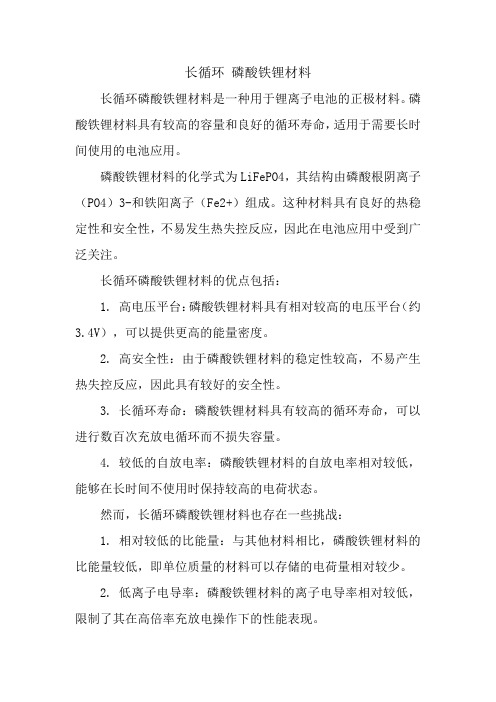
长循环磷酸铁锂材料
长循环磷酸铁锂材料是一种用于锂离子电池的正极材料。
磷酸铁锂材料具有较高的容量和良好的循环寿命,适用于需要长时间使用的电池应用。
磷酸铁锂材料的化学式为LiFePO4,其结构由磷酸根阴离子(PO4)3-和铁阳离子(Fe2+)组成。
这种材料具有良好的热稳定性和安全性,不易发生热失控反应,因此在电池应用中受到广泛关注。
长循环磷酸铁锂材料的优点包括:
1. 高电压平台:磷酸铁锂材料具有相对较高的电压平台(约3.4V),可以提供更高的能量密度。
2. 高安全性:由于磷酸铁锂材料的稳定性较高,不易产生热失控反应,因此具有较好的安全性。
3. 长循环寿命:磷酸铁锂材料具有较高的循环寿命,可以进行数百次充放电循环而不损失容量。
4. 较低的自放电率:磷酸铁锂材料的自放电率相对较低,能够在长时间不使用时保持较高的电荷状态。
然而,长循环磷酸铁锂材料也存在一些挑战:
1. 相对较低的比能量:与其他材料相比,磷酸铁锂材料的比能量较低,即单位质量的材料可以存储的电荷量相对较少。
2. 低离子电导率:磷酸铁锂材料的离子电导率相对较低,限制了其在高倍率充放电操作下的性能表现。
3. 价格较高:由于磷酸铁锂材料的生产成本较高,使得它在某些应用中面临竞争压力。
总的来说,长循环磷酸铁锂材料是一种具有潜力的正极材料,适用于需要长时间使用且对安全性要求较高的电池应用。
未来的研究和技术改进可能会进一步提高其性能,并扩大其在各个领域的应用范围。
- 1、下载文档前请自行甄别文档内容的完整性,平台不提供额外的编辑、内容补充、找答案等附加服务。
- 2、"仅部分预览"的文档,不可在线预览部分如存在完整性等问题,可反馈申请退款(可完整预览的文档不适用该条件!)。
- 3、如文档侵犯您的权益,请联系客服反馈,我们会尽快为您处理(人工客服工作时间:9:00-18:30)。
Lithium Iron Phosphate ChemistryDate: 7/27/10 Rev. 1.3MATERIAL SAFETY DATA SHEET (MSDS) Section 1. Product And Company IdentificationProduct name: Li-Ion Cells or Battery Pack Product description: Lithium Iron Phosphate Chemistry Product Size: Large Format Prismatic Type Cell (for all sizes) Company Name: International Battery, Inc. Address: 6845 Snowdrift Road, Allentown, PA-18106, USA Telephone Number: 610-366-3925 Fax Number: 610-366-3929 Emergency Telephone Number: Chemtrec for Spills, Leaks, USA 1-800-424-9300 International 703-527-3887Section 2. Composition/Information on IngredientsCommon Chemical Name Lithium Iron Phosphate (LiFePO4) Carbon, as Graphite Aluminum metal Copper metal Electrolyte Ethylene carbonate Dimethyl carbonate Ethyl methyl carbonate Lithium Hexafluorophosphate 96-49-1 616-38-6 623-53-0 21324-40-3 CAS # 15365-14-7 7440-44-0 7429-90-5 7440-50-8 Percent of Content (%) 30-33 15-17 5-7 7-9 15-20 Classification and Hazard Labelling Eye, Skin, Respiratory Irritant Eye, Skin, Respiratory Irritant Inert Inert Mixture: Flammable; Reactive; Sensitizer; Eye, Skin & Respiratory IrritantSection 3. Hazardous IdentificationLithium Ion batteries described in this MSDS data sheet are hermetically sealed and designed to withstand temperatures and pressures encountered during normal use. Under normal conditions of use, there is no physical danger of ignition, explosion or chemical danger of hazardous materials leakage. The materials contained in this battery may only represent a hazard if the integrity of the battery is compromised or if the battery is mechanically, thermally or electrically abused. Caution: Do not open or disassemble the batteries. Do not expose the batteries to fire or open flame. Do not mix batteries of varying sizes, chemistries, or types. Do not short circuit, puncture, incinerate, crush, over-charge, over discharge, or expose the batteries to temperatures above the declared limit. Abuse of the batteries will result in the risk of fire or explosion, which could release hydrogen fluoride gas.Lithium Iron Phosphate ChemistryDate: 7/27/10 Rev. 1.3MATERIAL SAFETY DATA SHEET (MSDS)Human Health Hazard: Electrolyte may irritate skin and eyes. In the event of a battery rupture, electrolyte fumes/gases can cause serious damage to the eye and can cause sensitization and irritation to the respiratory tract.Section 4. First Aid MeasuresGeneral: In an event of battery fire or rupture, evacuate personnel from the contaminated area. Eye contact: Flush with plenty of water for at least 15 minutes (eyelids held open). Seek medical attention immediately. Inhalation: Leave area immediately. Seek medical attention immediately. Skin contact: Remove contaminated clothing. Wash the area with soap and plenty of water immediately and for at least 15 minutes. Seek medical attention. Ingestion: Drink plenty of water and induce vomiting. Seek medical attention immediately.Section 5. Fire Fighting Measures:Extinguishing Media: Plenty of water, Carbon dioxide gas, Chemical powder, fire extinguishing medium and foam. Fire Fighting Procedures: Use a positive pressure self-contained breathing apparatus if batteries are involved in fire. Full protective clothing is necessary. During water application, caution is advised as burning pieces of flammable particles may be ejected from the fire. Hazardous Combustion products: Fire, excessive heat and/or over voltage conditions may produce hazardous decomposition products (i.e. electrolyte fumes and hazardous organic vapors). Vapors may be heavier than air and may travel along the ground or be moved by ventilation to an ignition source.Section 6. Accidental Release Measures:Remove all personnel from the area immediately. Wear protective gloves and protective glasses. The spilled solids are to be put into a sealed plastic bag or container and disposed off properly (after cooling if necessary). Any leaked electrolyte should be wiped off with dry cloth and disposed off properly (section 13). Do not inhale the gas and avoid skin contact. Do not bring collected materials close to fire.Section 7. Handling and Storage:Handling: Do not open or disassemble the batteries. Do not expose the batteries to fire or store near open flame. Do not mix batteries of varying sizes or chemistries. Do not connect the positive and negative battery terminals with conductive material or throw into fire. Do not heat or solder the batteries. Keep the batteries in plastic or non-conductive trays. Do not expose batteries to direct sun light for a prolonged time. Storage: Batteries should be stored in a well ventilated, cool area with sufficient clearance between batteries and walls. Store the batteries in a cool (below 300C) area and away fromLithium Iron Phosphate ChemistryDate: 7/27/10 Rev. 1.3MATERIAL SAFETY DATA SHEET (MSDS)moisture. Keep the batteries away from sources of heat, open flames, food and drink. Do not store the batteries above 550C or below -300C . Storing at elevated temperatures may reduce the life of batteries. Keep batteries away from strong oxidizers and acids. Elevated temperature storage such as 1000C may result in battery venting flammable liquid and gases.Section 8. Exposure Controls/Personal Protection:No engineering controls are required for normal operation. In case of cell leakage, increase the ventilation and use self contained full-face respiratory equipment. Common Chemical Name/General Name Lithium Iron Phosphate Carbon, As Graphite Electrolyte OSHA PEL-TWA ACGIH (2010) TLV-TWA10.0 mg/m3 (as iron fume) 5.0 mg/m3 (as iron fume) 5.0 mg/m3 (respirable fraction) 2.0 mg/m3 (respirable fraction) Not Established Not EstablishedOSHA: Occupational Safety and Health Administration PEL-TWA: Permissible Exposure Limits-Time Weighted Average Concentration ACGIH: American Council of Government Industrial Hygienists TLV-TWA: Threshold Limit Value-Time Weighted Average ConcentrationPersonal Protective Equipment Not required during normal use of the battery In the event of a ruptured battery or fire Respiratory Protection: Self-contained full-face respiratory equipment. Hand Protection: Chemical protective gloves. Eye protection: Self-contained full-face respiratory equipment. Skin and body protection: Chemical-protective clothing.Section 9. Physical and Chemical Properties:Appearance: Green/Blue plastic cases with or without ribs hermetically sealed and fitted with metallic terminals/connections. Odor: No odor pH: NA Flash Point: NA Explosion properties: NA Density: NA Solubility with indication of Solvent(s): Insoluble in water.Lithium Iron Phosphate ChemistryDate: 7/27/10 Rev. 1.3MATERIAL SAFETY DATA SHEET (MSDS) Section 10. Stability and Reactivity:Stability: Stable under normal conditions. Reactivity: When a battery is exposed to high temperatures, crushes, deformation, and external short circuit may result in venting harmful gases and volatile organics. In the event of rupture, hydrogen fluoride gas is produced in reaction with water.Section 11. Toxicological Information:There is no available data for the product itself. The information for the internal cell materials are as follows: Irritancy: The electrolytes contained in the battery can irritate eyes with any contact. Prolonged contact with skin or mucus membrane may cause irritation. Sensitization: The nervous system of respiratory organs may be stimulated sensitively. Carcinogenicity: No information is available at this time. Reproductive toxicity: No information is available at this time. Teratogenicity: No information is available at this time. Mutagenicity: No information is available at this time.Section 12. Ecological Information:Not applicable for this product.Section 13. Disposal Considerations:Batteries should be discharged fully prior to disposal. The battery terminals should be capped to prevent a short circuit. Dispose the batteries in accordance with applicable local laws. Li-ion batteries may be subject to federal, state or local regulations.Section 14. Transportation information:In the case of transportation, avoid exposure to high temperature and prevent the formation of any condensation. The container must be handled carefully. Prevent the collapse of the cargo piles and wetting by rain. Please refer to section 7 for handling and storage instruction. UN classification: International Battery, Inc. products’ shipping name is “Lithium ion batteries”.Section 15. Regulatory information:The transport of rechargeable lithium-ion batteries is regulated by various bodies (IATA, IMO, ADR, US-DOT) that follow the United Nations “Recommendation on the Transport of Dangerous Goods, Model regulations, 13th Revised edition-2003-Ref. STSG/AC.10/1 Rev. 13”. International Battery, Inc. products are assigned to UN3480 and are restricted by this regulation.Section 16. Other Information/Disclaimer:The information contained in this material data sheet has been compiled from sources considered to be dependable and is to the best of the knowledge and belief of International Battery, Inc.,Lithium Iron Phosphate ChemistryDate: 7/27/10 Rev. 1.3MATERIAL SAFETY DATA SHEET (MSDS)accurate and reliable as of the date of compilation. However, no representation, warranty (either expressed or implied) or guarantee is made to the accuracy, reliability or completeness of the information obtained herein. This information relates to the specific materials designated and may not be valid for such materials used in combination with any other materials or in any process. It is the user’s responsibility to satisfy himself as to the suitability and completeness of this information for his particular use. International battery, Inc. does not accept liability for any loss or damage that may occur whether direct, indirect, incidental or consequential, from the use of this information. International battery, Inc. does not offer warranty against patent infringement. Additional information is available by calling the telephone number designated above for this purpose.。
